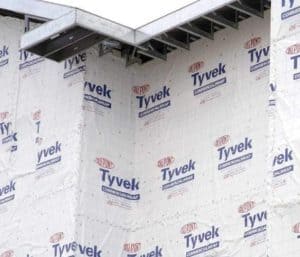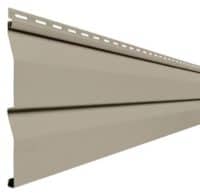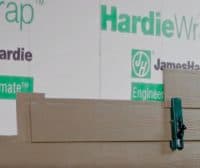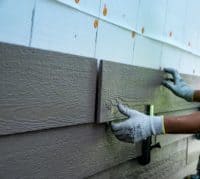As a homeowner it is important to educate yourself on how to properly maintain your home in order to preserve its value and structural integrity. This is especially true if you have an older dwelling and upgrades are needed such as a new roof, gutters, windows or siding.
Many homeowners rely on the advice of contractors that are solicited for bids in performing these retro upgrades. Although many home restoration contractors give sound advice, unfortunately many others do shoddy installations and cut corners with cheap materials and poor craftsmanship. In this article were going to focus on upgrading your home with new siding and what to look for when picking your siding contractor in the Waukesha and Milwaukee metro area.
We’ll presume that the old siding is being removed – which is highly recommended. As such, a couple of the primary components of installing new siding on your house is assuring that there is proper insulation in the wall cavities, and that house wrap is installed.
WALL INSULATION
Depending on what year your home was built in, there may or may not be adequate insulation in the wall cavities. Typically homes built in the late 1940’s to mid1960’s are not going to have sufficient insulation to keep your home cooler in the summer, and warmer during Wisconsin’s blustery cold winters. Also, the exterior walls on older homes were covered with 1×8 and 1×10 boards; leaving many cracks for wind and air to seep in.
In any case, the exterior walls should be inspected for proper insulation, and the cost for installing 1/4-inch Fanfold insulation should wisely be factored into the bid when installing new siding on your home. Applying 1/4 inch foam insulation and properly taping all seams will greatly reduce leaking and increase the reduction of energy costs.
HOUSE WRAP
 House wrap should never be an option and should always be applied when installing new siding. House wraps brands such as Typar® and Tyvek® are a moisture and air barrier that seals gaps and leaks on the exterior of your house. The gaps and leaks are typically in the seams of the boards or plywood sheathing that makes up the layer of the exterior walls beneath your home’s siding.
House wrap should never be an option and should always be applied when installing new siding. House wraps brands such as Typar® and Tyvek® are a moisture and air barrier that seals gaps and leaks on the exterior of your house. The gaps and leaks are typically in the seams of the boards or plywood sheathing that makes up the layer of the exterior walls beneath your home’s siding.
Typical house wrap is made of flash-spun, high-density polyethylene fibers that are highly durable. House wrap barriers allow water vapor to escape and pass through it, while blocking the passage of liquid. House wrap effectively resists air infiltration, thereby creating a protective shell on the exterior of your home and preventing air seepage.
SIDING
Now that the insulation and vapor barrier issues have been addressed it is time to consider the actual new siding that will be installed on your home. Generally speaking, there are three common types of siding to choose from: Vinyl, James Hardie, and LP SmartSide.
 Vinyl: Vinyl siding is by far the most common and inexpensive option for siding. There are many color options, and installation is relatively quick without the requirement of caulk and other flashings. Vinyl siding, however, is essentially plastic that is susceptible to fading, cracking. It is also vulnerable to being blown off in wind storms due to its loose application that is required for expansion and contraction. Additionally, vinyl siding does not offer the best resale value for your home compared to other siding options.
Vinyl: Vinyl siding is by far the most common and inexpensive option for siding. There are many color options, and installation is relatively quick without the requirement of caulk and other flashings. Vinyl siding, however, is essentially plastic that is susceptible to fading, cracking. It is also vulnerable to being blown off in wind storms due to its loose application that is required for expansion and contraction. Additionally, vinyl siding does not offer the best resale value for your home compared to other siding options.
 James Hardie: James Hardie siding is a fibre cement material that is durable and comes pre-finished in a host of color options. Although the cost for installation is nominally more expensive than vinyl, the value that James Hardie adds to your home is without parallel when it comes to longevity and value. Essentially these prefinished cement planks are tightly fastened to the exterior of your home and sealed with caulk. It is dense and durable; even withstanding heavy wind storms like we face here is Waukesha County, WI.
James Hardie: James Hardie siding is a fibre cement material that is durable and comes pre-finished in a host of color options. Although the cost for installation is nominally more expensive than vinyl, the value that James Hardie adds to your home is without parallel when it comes to longevity and value. Essentially these prefinished cement planks are tightly fastened to the exterior of your home and sealed with caulk. It is dense and durable; even withstanding heavy wind storms like we face here is Waukesha County, WI.
 LP SmartSide: LP SmartSide is made from wood strands and fibers that are treated with zinc borate to resist damage from termites and fungal decay. Like James Hardie, it is durable, but it comes only primed and must be painted. Additionally, all edges must be primed and painted during installation to prevent decay and weathering.
LP SmartSide: LP SmartSide is made from wood strands and fibers that are treated with zinc borate to resist damage from termites and fungal decay. Like James Hardie, it is durable, but it comes only primed and must be painted. Additionally, all edges must be primed and painted during installation to prevent decay and weathering.

